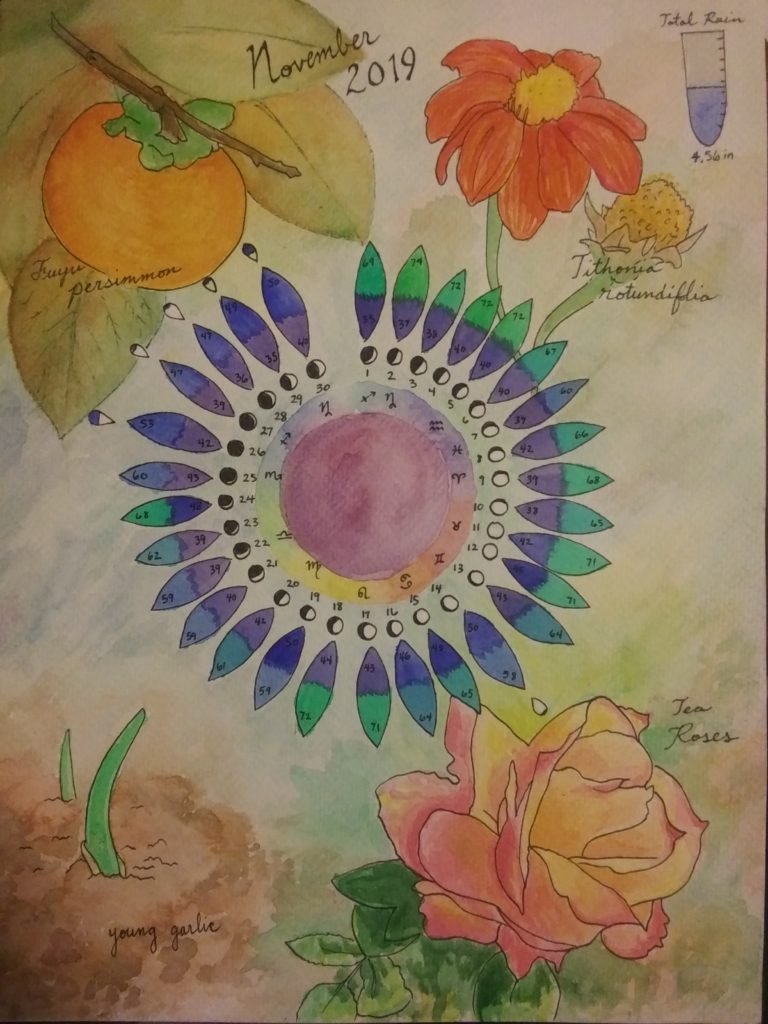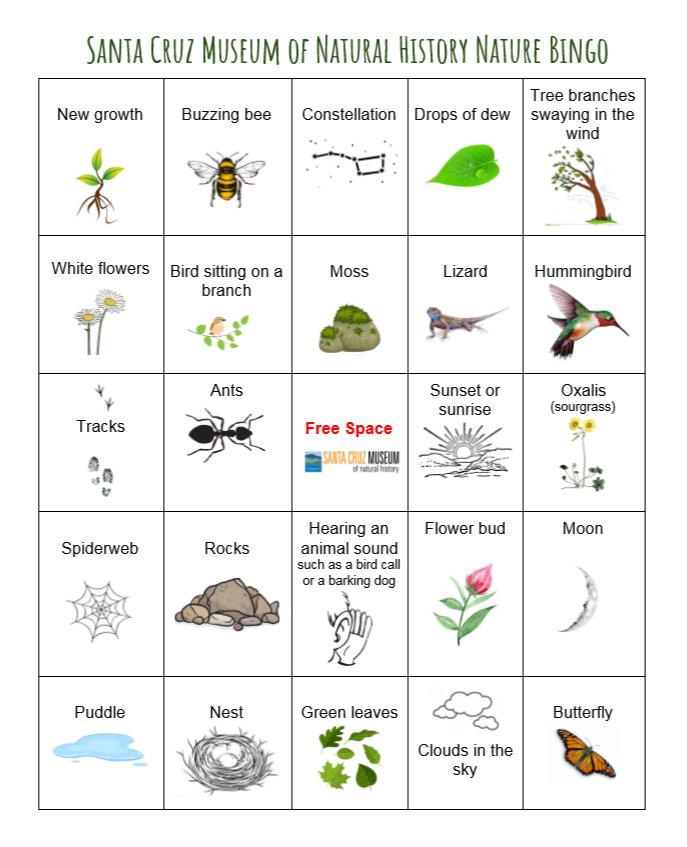Museums might be closed but in this video you can learn to make your own natural history museum at home! Include a favorite exhibit from the Santa Cruz Museum of Natural History as well as your own curations.
Post by Elise.
Family-friendly activities, videos, articles, and more to aid in your nature exploration!
Museums might be closed but in this video you can learn to make your own natural history museum at home! Include a favorite exhibit from the Santa Cruz Museum of Natural History as well as your own curations.
Post by Elise.
Do you enjoy looking at flowers? What do you want to learn about flowers? Use this step-by-step guide to learn about the different parts of a flower through illustration. Afterwards you will be able to identify perfect and imperfect flowers.
Explore more about plants with the resources in our Online Museum Store.
Post by Elise
Discover some amazing properties of light with our Light Spectra Activity. Make your own scientific tool to see light in a new way–and figure out components of different sources of light!
Additional Resources:
All around us, things are constantly changing. Spring rains come and bring new flowers, baby birds are hatching from eggs, and new green leaves emerge on trees. Can you think of some ways you have observed changes in nature?

Here are some prompts to help inspire you to create your own wheel! Check out the detailed guide below for even more ideas.
Watch our Phenology Wheel Video.
Post by Ellen
In honor of the halfway point between the start of spring and the start of summer, make an ecologically conscious flower crown.
Post by Marisa

Spending time outside can help you feel connected to nature, but there are ways to connect to nature without leaving your house. Find a comfy spot to sit near a window and take 20 minutes to gaze out at the world. What will you notice during this time?
Capture a moment in time out your window through writing, questioning, and drawing. For further instructions, follow along with the activity guide.
Explore these other posts about journaling:
Post by: Elise
Slowing down and taking a small part of your day to be silent and listen can help you feel more relaxed and calm. Tune in to what is around you by making a map of sounds. Is there a bird chirping in the tree to your right? Water running in a creek behind you? Footsteps crossing on the sidewalk in front of you?
This 10-20 minute activity can be done with all ages and at any time of day. You will be surprised at how energetic kids (and adults) will calm down and sit for extended periods of time during this activity. For tips and tricks to do this listening activity with your whole, take a look at the Sound Map Activity Guide.
Explore these other posts about observing nature:
Post by: Elise
Reuse materials from your home to create a tool to help you observe the secret world of insects more closely — a bug net!
Post by Marisa
Who is a naturalist?
It doesn’t take much to be a naturalist – anyone can be one! A naturalist is someone who enjoys spending time in nature, exploring aspects of the natural world, and making observations about the things that they see. Does that sound like you? If so, you are a naturalist! A naturalist is CURIOUS, EXCITED about learning and discovering, and RESPECTFUL towards all living and non-living beings in the world.
What do you need to be a naturalist?
Your most important tools are the senses you have available to you. Those senses may include: SIGHT, HEARING, TOUCH, SMELL, and TASTE. You can use these “tools” in so many ways to observe your surroundings and to discover patterns in nature!There are some other tools that naturalists bring with them to investigate nature more closely. Many of these tools can fit right inside a backpack, meaning that you can take them anywhere!
Safety first!
Before we talk about WHAT you can bring on your adventure in nature, it’s important that we go over a few things to help keep you and the environment safe.
Journal and Art Supplies
A great place to start is with paper and pen or pencil. An important part of being a naturalist is taking notes and recording the things you see!
Why do you think it’s important to record observations in this way?
If you like to draw, you can take your favorite art supplies with you to make sketches of the things you see. There is no wrong way to nature journal! Ask questions in your journal, get creative, make graphs – it’s up to you!
If you’re stuck on what to write about, you can try “I Notice, I Wonder, and It Reminds Me Of”. All you have to do is choose something you see in nature and finish those sentences based off of the observations that you’re making with your senses!
Some good resources to help you with nature journaling:
What’s That?
Have you ever been on a walk in nature, saw something AMAZING , and wondered, “What IS that?”. This is where field guides come in handy! A field guide is a book or handout that helps you identify things that you can find in the natural world. There are so many field guides out there in the world – whatever you are interested in, there is definitely a field guide for it!
Field guides are great to use after you have spent time with your organism, making observations about what you notice about it. They can tell you the name of the organism as well as any other cool information about it!
There are a lot of helpful books to get you started on your identification. Field guides can be foldable pamphlets, too – easy to carry around in a backpack! There are also so many field guides online that you can download to either print or view. You can even create your own field guide!
Look Closer!
Up close or far away – there are a lot of tools we can use to help us focus our eyes on the things we see in nature! Here are just a few.
Binoculars
Look! There’s a bird perched high up in that tree. One way to look at it a little more closely is by using a pair of binoculars. Binoculars are tools that have two lenses for your eyes that help magnify your vision.
How to Use Binoculars
Magnifying Glass or Hand Lens
These tools help us see details up close- like the scales on a butterfly wing, tiny hairs on a fuzzy plant, or tiny organisms swimming around in the water! Peer into a magnifying glass or hand lens and see what you can find.
Good places to find these tools:
Gettin’ Buggy!
Watch a spider spinning its web, follow a butterfly from flower to flower, or watch a worm wriggle in the dirt! There is so much to learn about these tiny creatures – they are not to be overlooked!
There are ways we can safely look more closely at insects. An insect net is a tool that helps you safely capture insects so that you can make observations. You can carry some small jars with holes in the lid or sides to create a temporary home for the insect while you take a closer look. It is always better to just look with our eyes when we find insects, but if we are careful, we can use these tools to get a better understanding of our six-legged friends.
Remember! Never pick up or touch an insect you are not familiar with. Make sure to be gentle when using your net to observe living creatures. Always release insects in the same place you found them after you are done making observations!
Now your bag is all packed and you’re ready to explore!
Who knows what wonderful surprises you’ll find out in nature?
Post by: Ellen
Play this bingo game during your time at home, yard, or neighborhood! Throughout the day stop to look out your window and see if you can find any of the things listed on the board. Try looking out all the windows in your house and at different times of day. Aim for 5 in a row, or find them all and call yourself a nature detective!

Post by: Elise